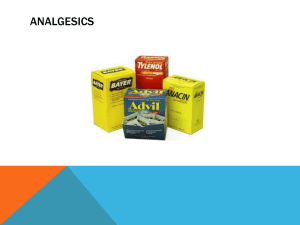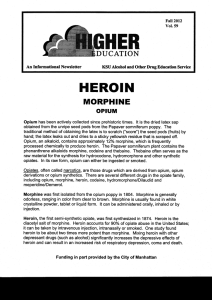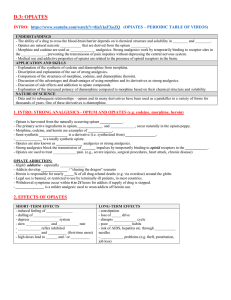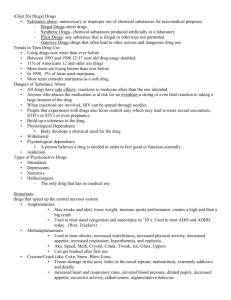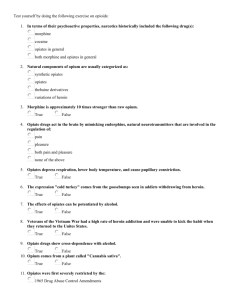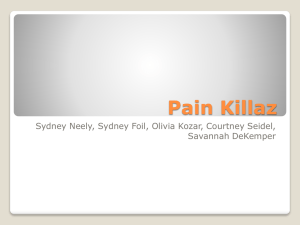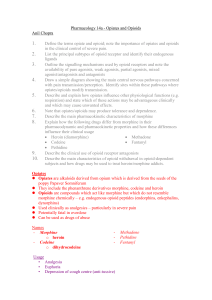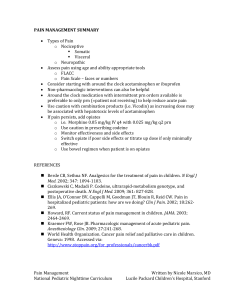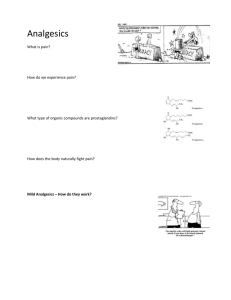1. Analgesic
advertisement
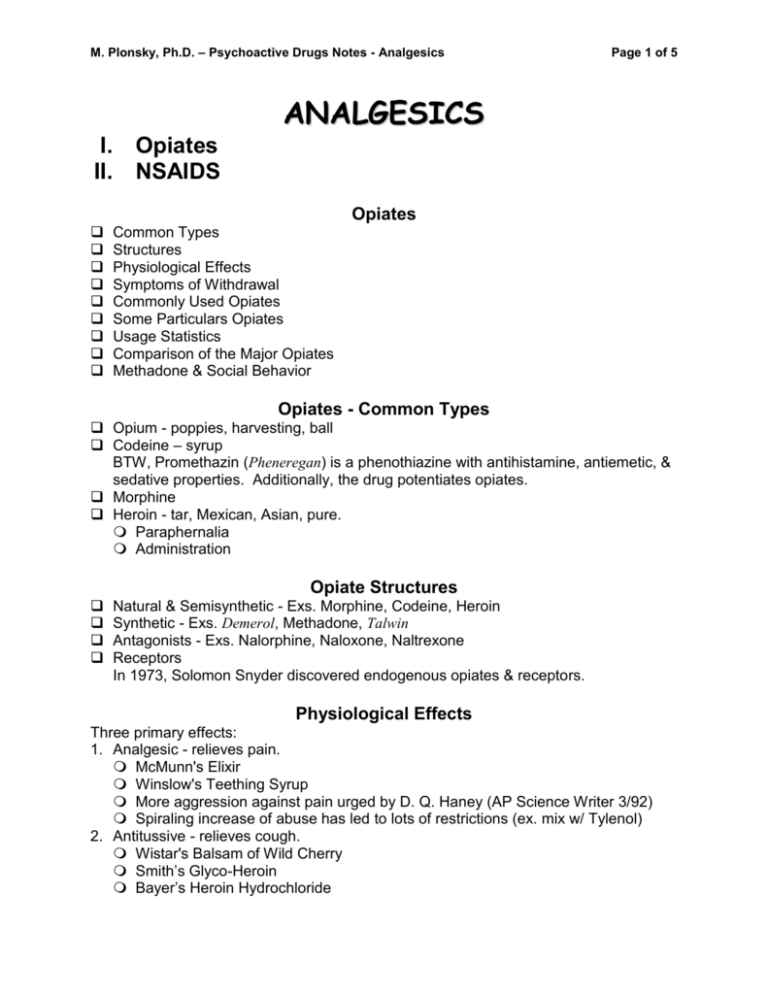
M. Plonsky, Ph.D. – Psychoactive Drugs Notes - Analgesics Page 1 of 5 ANALGESICS I. Opiates II. NSAIDS Opiates Common Types Structures Physiological Effects Symptoms of Withdrawal Commonly Used Opiates Some Particulars Opiates Usage Statistics Comparison of the Major Opiates Methadone & Social Behavior Opiates - Common Types Opium - poppies, harvesting, ball Codeine – syrup BTW, Promethazin (Pheneregan) is a phenothiazine with antihistamine, antiemetic, & sedative properties. Additionally, the drug potentiates opiates. Morphine Heroin - tar, Mexican, Asian, pure. Paraphernalia Administration Opiate Structures Natural & Semisynthetic - Exs. Morphine, Codeine, Heroin Synthetic - Exs. Demerol, Methadone, Talwin Antagonists - Exs. Nalorphine, Naloxone, Naltrexone Receptors In 1973, Solomon Snyder discovered endogenous opiates & receptors. Physiological Effects Three primary effects: 1. Analgesic - relieves pain. McMunn's Elixir Winslow's Teething Syrup More aggression against pain urged by D. Q. Haney (AP Science Writer 3/92) Spiraling increase of abuse has led to lots of restrictions (ex. mix w/ Tylenol) 2. Antitussive - relieves cough. Wistar's Balsam of Wild Cherry Smith’s Glyco-Heroin Bayer’s Heroin Hydrochloride M. Plonsky, Ph.D. – Psychoactive Drugs Notes - Analgesics Page 2 of 5 3. Constipation - firms the stool. Side Effects Drowsiness, mental clouding Respiratory depression Nausea, vomiting, & constipation Inability to urinate Drop in blood pressure Abuse potential Symptoms of Withdrawal Symptoms (hours till shown) Craving for drugs, anxiety. Yawning, perspiration, runny nose, tears. Pupil dilatation, goose bumps, muscle twitches, muscle aches, hot & cold flashes, anorexia. Increased intensity of above, insomnia, raised BP, fever, faster pulse, nausea. Increased intensity of above, curled-up position, vomiting, diarrhea, increased blood sugar, & “kicking the habit”. Hero. 4 Morp. 6 Meth. 24-48 8 14 34-48 12 16 48-72 18-24 24-36 72+ 26-36 36-48 na Some Particular Opiates Oxycontin - popularity soared in the late 90s. Users grind up the tablets & snort the powder, or mix it with water & inject it like heroin. Krokodil - Desomorphine A derivative of morphine invented in 1932 in the US. -10x stronger than morphine). Described as having a fast onset & short duration of action, with relatively little nausea or respiratory depression compared to equivalent doses of morphine. Attracted attention in 2010 in Russia due to an increase in clandestine production, presumably due to its relatively simple synthesis from codeine. Made in a process similar to the manufacture of methamphetamine from pseudoephedrine. Thus, like meth, is often highly impure. The street name for home-made desomorphine is "krokodil" (crocodile), reportedly due to the scale-like appearance of skin of its users & the derivation from chlorocodide. Due to difficulties in procuring heroin combined with easy/cheap access to OTC products containing codeine in Russia, its use has been on the rise. High is similar to heroin but shorter. While heroin lasts 4-8 hours, effects of krokodil lasts 1-1.5 hours. Tramadol (Ultram-1994 in US) M. Plonsky, Ph.D. – Psychoactive Drugs Notes - Analgesics Page 3 of 5 A centrally acting synthetic analgesic used to treat moderate to moderately severe pain. Is an atypical opioid which has become very popular. A very weak µ-opioid receptor agonist, induces serotonin release, and inhibits the reuptake of norepinephrine. Thus, it has properties of analgesics & antidepressants (the latter of which are sometimes used to treat pain, btw). Extended-Release (ER) formulation available in 2005. Used in veterinary practice as well as humans. Not a federally controlled drug, however, several states have elected to make it Schedule IV. Tapentadol Tapentadol a new synthetic atypical opioid made to mimic the agonistic properties of tramadol's metabolite, M1(O-Desmethyltramadol). Potency is somewhere between tramadol & morphine. It is the closest chemical relative of tramadol in use. It is Schedule II (i.e., federally controlled). Dextromethorphan DXM is an antitussive with sedative & dissociative properties. It is an active ingredient in many OTC cold meds. Triple C’s (Corcidin Cough & Cold – DXM, Tylenol, Pseudoephedrine) When used recreationally (at doses up to 75x reco’d), it produces effects similar to the dissociative hallucinogenic states created by ketamine & PCP. It may produce distortions of vision, feelings of dissociation, distorted bodily perception, & excitement, as well as a loss of sense of time. The recreational effects occur in a non-linear fashion, so that they are experienced in significantly varied stages. These stages are commonly referred to as “plateaus”. Comparison of the Major Opiates Generic Brand Duration Name Name Potency of Action Morphine 1 4-5 (hrs) Heroin 4 3-4 Hydromorphone Dilaudid 5 4-5 Codeine .1 4-6 Oxycodone/Asp Percodan .75 4-5 Methadone Dolophine 1 24-48 Meperidine Demerol .1 2-4 Propoxyphene Darvon .05 6 Fentanyl Sublimaze 80 1-3 Pentazocine Talwin .2 2-3 Note: Potency estimates are presented relative to an effective dose of morphine. Methadone & Social Behavior Plonsky & Freeman, 1980 Tested pairs of rats given one of 4 dosage levels for 300 sec on 6 days in a circular open field. Measured: Time in Contact - time spend touching. M. Plonsky, Ph.D. – Psychoactive Drugs Notes - Analgesics Page 4 of 5 Activity Levels - defined by photo-beam counts. NSAIDs Classification Physiological Effects Common Side Effects Compositions of OTC Varieties NSAID Classification Are the most frequently used (& biggest money makers) of OTC medications. Two broad categories: 1. Salicylates - includes: Aspirin Acetaminophen (Tylenol) 2. Others Ibuprofen - Advil, Motrin Naproxen – Aleve Ketoprofen - Orudis KT Naproxen (Aleve) Available as prescription since 1976 & became available OTC in 1994. Rather than having to take a dose every 3-8 hours, as with other OTC NSAIDS, a single dose of naproxen lasts for 8-12 hours. For patients with pain that does not go away and stay away-say, back pain or persistent menstrual cramps, or the pain of an injury or surgical procedure-a longeracting analgesic may be more convenient and help the patients sleep better. However, for short-term pain, like a tension headache, there would be no particular advantage to taking Aleve. NSAID Physiological Effects Analgesia - Works for somatic rather than visceral pain. Antipyretic - Reduces fever. Careful here though as you should let a low grade fever (<101°F) do its work. It enables the body to fight infection. Anti-inflammatory - Reduces swelling (except acetaminophen). Need high, sustained doses for this effect. Reye's Syndrome Disease is believed to be caused by medicines that contain salicylate. Affects mostly young folks & appears soon after a flu-like infection or chicken pox. Death is common & may occur in only a few days. Symptoms were recognized as a distinct disease in 1963 by Ralph Douglas Reye, M.D., an Australian pathologist. Although the precise cause remains unknown, it is clear that ingestion of aspirin during/after a viral illness, significantly increases the chance of the disease. M. Plonsky, Ph.D. – Psychoactive Drugs Notes - Analgesics Page 5 of 5 In 1977, there were >500 cases found by the CDC, but by 1985 only 93 cases were found. Currently it is 50/year. Although it affects all ages, more than 90% of those affected are under age 15. Compositions of OTC Varieties AcetamIbuProduct Aspirin inophen profen Other Anacin 400 caffeine Bayer 325 Alka-Seltzer 325 antacid Ascriptin A/D 325 maalox Ecotrin 325 coated Excedrin 250 250 caffeine Anacin 3 325 Datril 500 Tylenol 325 Advil 200 CoAdvil 200 decon. Nuprin 200 Note: values are in mgs. Buffering (antacid, maalox) curbs gastric effects somewhat. Enteric coating (causes absorption from intestine rather than stomach) works better. But coating also slows absorption and thus delays the pain-relief.
